Ford GT40
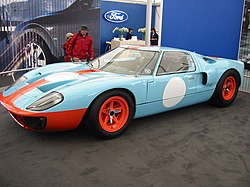 |
| Manufacturer | Ford Advanced Vehicles
J.W. Automotive |
|---|
| Production |
1964-1969
107 produced |
|---|
| Successor | Ford P68 |
|---|
| Class | Group 4 Sports Car
Group 6 Sports Prototype |
|---|
| Body style | Coupe
Roadster |
|---|
| Engine | 4181 cc (255 CID) V-8
4737 cc (289 CID) V-8
6997 cc (427 CID) V-8
4942 cc (302 CID) V-8 |
|---|
| Transmission | 5-speed manual |
|---|
| Wheelbase | 95 in (2,413 mm) |
|---|
| Length | 160 in (4,064 mm) |
|---|
| Width | 70 in (1,778 mm) |
|---|
| Height | 40.5 in (1,029 mm) |
|---|
| Curb weight | 2,002 lb (908 kg) |
|---|

Ford GT40 Mk II front. This car took second place overall (all three top finishers were Ford GT40s) in the 1966 24 Hours of Daytona. The #1 car was driven by Ken Miles and Lloyd Ruby, and together with the #2 car driven by Bruce McLaren/Chris Amon (1st overall) and #5 car driven by Bucknum/Hutcherson (3rd overall) gave Ford its first victory in a 24 hour race. The photo shows the livery as used at Le Mans in 1966. (Serial Number GT-40 P 1015 Mk. II)
The Ford GT40 is a high performance British-American sports car and winner of the 24 Hours of Le Mans four times in a row, from 1966 to 1969 (1966 being the Mk II,1967 the Mk IV, and 1968-1969 the oldest chassis design, the Mk I). With this car Ford became in 1966 the first and so far the only American constructor to win overall at Le Mans. In addition to that, the Mk IV became in 1967 so far the only racecar built entirely in the United States to win overall at Le Mans, whilst in the previous year Ford won with a British-built chassis and only an engine came from America.
It was built to win long-distance sports car races against Ferrari (who won at Le Mans six times in a row from 1960 to 1965). Chassis # P-1075, which won in 1968 and 1969, is the first car in Le Mans history to win the race more than once with the same chassis, and one of three cars to have won with the same chassis.) using a Ford engine originally 4.7- litre, enlarged to 4.9-litre (also known as a 5.0) with special alloy Gurney-Weslake cylinder head.
The car was named the GT (for Grand Touring) with the 40 representing its overall height of 40 inches (1.02 m, measured at the windshield) as required by the rules. Large displacement Ford V8 engines (4.2 litre, 4.7 litre and 7 litre) were used, compared with the Ferrari V12 which displaced 3.0 litres or 4.0 litres.
Early cars were simply named "Ford GT". The name "GT40" was the name of Ford's project to prepare the cars for the international endurance racing circuit, and the quest to win the 24 Hours of Le Mans. The first 12 "prototype" vehicles carried serial numbers GT-101 through GT-112. The "production" began and the subsequent cars, the MkI, MkII, and MkIIIs, (with the exception of the MkIV, which were numbered J1-J10) were numbered GT40P/1000 through GT40P/1145, were officially "GT40s". The name of Ford's project, and the serial numbers dispel the story that "GT40" was "only a nickname."
The contemporary Ford GT is a modern homage to the GT40.
History
Henry Ford II had wanted a Ford at Le Mans since the early 1960s.
In the spring of 1963, Ford reportedly received word through a European intermediary that Enzo Ferrari was interested in selling to Ford Motor Company. Ford reportedly spent several million dollars in an audit of Ferrari factory assets and in legal negotiations, only to have Ferrari unilaterally cut off talks at a late stage due to disputes about the ability to direct open wheel racing. Ferrari, who wanted to remain the sole operator of his company's motor sports division, was angered when he was told that he would not be allowed to race at the Indianapolis 500 if the deal went through since Ford fielded Indy cars using the company's engine, and didn't want competition from Ferrari. Enzo cut the deal off out of spite and Henry Ford II, enraged, directed his racing division to find a company that could build a Ferrari-beater on the world endurance-racing circuit.
To this end Ford began negotiation with Lotus, Lola, and Cooper. Cooper had no experience in GT or prototype and its performances in Formula One were declining.
Lotus was already a Ford partner for their Indy 500 project. Ford executives already doubted the ability of Lotus to handle this new project. Colin Chapman probably had similar views as he asked a high price for his contribution and insisted that the car (which became the Lotus Europa) should be named a Lotus-Ford, an attitude that can be viewed as polite refusal.
The Lola proposal was chosen, since Lola had used a Ford V8 engine in their mid-engined Lola Mk 6 (also known as Lola GT). It was one of the most advanced racing cars of the time, and made a noted performance in Le Mans 1963, even though the car did not finish, due to low gearing and so revving out on the Mulsanne Straight. However, Eric Broadley, Lola Cars' owner and chief designer, agreed on a short-term personal contribution to the project without involving Lola Cars.
The agreement with Broadley included a one-year collaboration between Ford and Broadley, and the sale of the two Lola Mk 6 chassis built to Ford. To form the development team, Ford also hired the ex-Aston Martin team manager John Wyer. Ford Motor Co. engineer Roy Lunn was sent to England; he had designed the mid-engined Mustang I concept car powered by a 1.7 litre V4. Despite the small engine of the Mustang I, Lunn was the only Dearborn engineer to have some experience with a mid-engined car.
Overseen by Harley Copp, the team of Broadley, Lunn and Wyer began working on the new car at the Lola Factory in Bromley. At the end of 1963 the team moved to Slough, near Heathrow airport. Ford then established Ford Advanced Vehicles Ltd, a new subsidiary under the direction of Wyer, to manage the project.
The first chassis built by Abbey Panels of Coventry was delivered on March 16, 1963. The first "Ford GT" the GT/101 was unveiled in England on April 1 and soon after exhibited in New York.
It was powered by the 4.2 L Fairlane engine with a Colotti transaxle, the same power plant was used by the Lola GT and the single-seater Lotus 29 that came in a highly controversial second at the Indy 500 in 1963. (A DOHC head design was used in later years at Indy. It won in 1965 in the Lotus 38.)
The Ford GT40 was first raced in May 1964 at the Nürburgring 1000 km race where it retired with suspension failure after holding second place early in the event. Three weeks later at the 24 Hours of Le Mans, all three entries retired although the Ginther/Gregory car led the field from the second lap until its first pitstop. After a season-long series of dismal results under John Wyer in 1964, the program was handed over to Carroll Shelby after the 1964 Nassau race. The cars were sent directly to Shelby, still bearing the dirt and damage from the Nassau race. Carroll Shelby was noted for complaining that the cars were poorly maintained when he received them, but later information revealed the cars were packed up as soon as the race was over, and FAV never had a chance to clean, and organize the cars to be transported to Shelby.
Shelby's first victory came on their maiden race with the Ford program, with Ken Miles and Lloyd Ruby taking a Shelby American-entered GT40 to victory in the Daytona 2000 in February 1965. The rest of the season, however, was a disaster.
The experience gained in 1964 and 1965 allowed the 7-litre Mk II to dominate the 24 Hours of Le Mans race in 1966 with a 1-2-3 result. The finish, however, was clouded in controversy: in the final few hours, the Ford GT of New Zealanders Bruce McLaren and Chris Amon closely trailed the leading Ford GT driven by Englishman Ken Miles and New Zealander Denny Hulme. With a multi-million-dollar program finally on the very brink of success, Ford team officials faced a difficult choice. They could allow the drivers to settle the outcome by racing each other – and risk one or both cars breaking down or crashing. They could dictate a finishing order to the drivers – guaranteeing that one set of drivers would be extremely unhappy. Or they could arrange a tie, with the McLaren/Amon and Miles/Hulme cars crossing the line side-by-side. The team chose the last and informed McLaren and Miles of the decision just before the two got in their cars for the final stint. Then, not long before the finish, the Automobile Club de l'Ouest (ACO), organizers of the Le Mans event, informed Ford that the geographical difference in starting positions would be taken into account at a close finish – meaning that the McLaren/Amon vehicle, which had started perhaps 60 feet (18 m) behind the Hulme-Miles car, would have covered slightly more ground over the 24 hours and would therefore be the winner. Secondly, Ford officials admitted later, the company's contentious relationship with Miles, its top contract driver, placed executives in a difficult position. They could reward an outstanding driver who had been at times extremely difficult to work with, or they could decide in favour of drivers (McLaren/Amon) with less commitment to the Ford program but who had been easier to deal with. Ford stuck with the orchestrated photo finish but Miles, deeply bitter over this decision after his dedication to the program, issued his own protest by suddenly slowing just yards from the finish and letting McLaren across the line first. Miles died in a testing accident in the J-car (later to become the Mk IV) at Riverside (CA) Raceway just two months later.
Miles' death occurred at the wheel of the Ford "J-car", an iteration of the GT40 that included several unique features. These included an aluminum honeycomb chassis construction and a "breadvan" body design that experimented with "kammback" aerodynamic theories. Unfortunately, the fatal Miles accident was attributed at least partly to the unproven aerodynamics of the J-car design, as well as the experimental chassis' strength. The team embarked on a complete redesign of the car, which became known as the Mk IV. The Mk IV, a newer design with a Mk II engine but a different chassis and a different body, won the following year at Le Mans(when four Mark IVs, three Mark IIs and three Mark Is raced). The high speeds achieved in that race caused a rule change, which already came in effect in 1968: the prototypes were limited to the capacity of to 3.0 litre, the same as in Formula One. This took out the V12-powered Ferrari 330P as well as the Chaparral and the Mk. IV. If at least 50 cars had been built, sportscars like the GT40 and the Lola T70 were allowed, with a maximum of 5.0 L. John Wyer's revised 4.7 litre (Bored to 4.9 litres, and o-rings cut and installed between the deck and head to prevent head gasket failure, a common problem found with the 4.7 engine.) Mk I. It won the 24 hours of Le Mans race in 1968 against the fragile smaller prototypes. This result, added to four other round wins for the GT40, gave Ford victory in the 1968 International Championship for Makes. The GT40's intended 3.0 L replacement, the Ford P68, and Mirage cars proved a dismal failure. In 1969, facing more experienced prototypes and the new yet still unreliable 4.5 L flat-12 powered Porsche 917s, the winners Jacky Ickx/Jackie Oliver managed to beat the remaining 3.0 litre Porsche 908 by just a few seconds with the already outdated GT40 (in the very car that had won in 1968 - the legendary GT40P/1075). Apart from brake wear in the Porsche and the decision not to change pads so close to the race end, the winning combination was relaxed driving by both GT40 drivers and heroic efforts at the right time by (at that time Le Mans' rookie) Ickx, who won Le Mans five times more in later years. In 1970, the revised Porsche 917 dominated, and the GT40 had become obsolete.
Versions
Mk I

A Ford GT40 Mk I competing in the 1969 Nurburgring 1000km race
The Mk I was the original Ford GT40. Early prototypes were powered by 4.2 litre (255 cu.in) alloy V8 engines and production models were powered by 4.7 litre (289 cu.in) engines as used in the Ford Mustang. Five prototype models were built with roadster bodywork, including the Ford X-1.The Ford X-1 was a roadster built to contest the Fall 1965 North American Pro Series, a forerunner of Can-Am, entered by the Bruce McLaren team and driven by Chris Amon. The car had an aluminum chassis built at Abbey Panels and was originally powered by a 4.7 liter (289ci) engine. The real purpose of this car was to test several improvements originating from Kar Kraft, Shelby and McLaren. Several gearboxes were used: a Hewland LG500 and at least one automatic gearbox. It was later upgraded to Mk II specifications with a 7.0 liter (427ci) engine and a standard four ratio Kar Kraft gearbox, however the car kept specific features such as its open roof and lightweight chassis. The car went on to win the 12 Hours of Sebring in 1966.
Mk II
The Mk II used the 7.0 litre (427ci) engine from the Ford Galaxie.
For Daytona 1967, two Mk II models (chassis 1016 and 1047) were fitted with Mercury 7.0 liter engines. Mercury is a Ford Motor Company division, and Mercury's 427 was exactly the same engine as Ford's with different logos. A batch of wrongly heat treated input shafts in the transaxles sidelined virtually every Ford in the race, however, and Ferrari won 1-2-3.
Mk III
The Mk III was a road-car only, of which 7 were built.The car had four headlamps, the rear part of the body was expanded to make room for luggage, the 4.7 litre engine was detuned to 335 bhp (250 kW), the shocks were softened, the shift lever was moved to the center and the car was available with the steering wheel on the left side of the car. As the Mk III looked significantly different from the racing models many customers interested in buying a GT40 for road use chose to buy a Mk I that was available from Wyer Ltd.
J-car

1967 Ford GT40 Mk IV, which was developed from the J-car
In an effort to develop a car with better aerodynamics and lighter weight, it was decided to retain the 7 litre engine, but redesign the rest of the car. In order to bring the car more "in house" and lessening partnership with English firms, Ford Advanced Vehicles was sold to John Wyer and the new car was designed by Ford's studios and produced by Ford's subsidiary Kar Kraft under Ed Hull. There was also a partnership with the Brunswick Aircraft Corporation for expertise on the novel use of honeycomb aluminium panels bonded together to form a lightweight but rigid "tub". The car was designated as the J-car, as it was constructed to meet the new Appendix J regulations which were introduced by the FIA in 1966.
The first J-car was completed in March, 1966 and set the fastest time at the Le Mans trials that year. The tub weighed only 86 lb (39 kg), and the entire car weighed only 2,660 lb (1,210 kg), 300 lb (140 kg) less than the Mk II. It was decided to run the MkIIs due to their proven reliability, however, and little or no development was done on the J-car for the rest of the season. Following Le Mans, the development program for the J-car was resumed, and a second car was built. During a test session at Riverside International Raceway in August 1966, with Ken Miles driving, the car suddenly went out of control at the end of Riverside's high-speed, 1-mile-long back straight. The honeycomb chassis did not live up to its design goal, shattering upon impact, bursting into flames and killing Miles. It was determined that the unique, flat-topped "bread van" aerodynamics of the car, lacking any sort of spoiler, were implicated in generating excess lift. Therefore a more conventional but significantly more aerodynamic body was designed for the subsequent development of the J-car which was officially known as the GT40 Mk IV. A total of nine cars were constructed with J-car chassis numbers although six were designated as Mk IVs and one as the G7A.
Mk IV
The Mk IV was built around a reinforced J chassis powered by the same 7.0 L engine as the Mk II. Excluding the engine, the Mk IV was totally different from other GT40s, using a specific chassis and specific bodywork. As a direct result of the Miles accident, the team installed a NASCAR-style steel-tube roll cage in the Mk. IV, which made it much safer but negated most of the weight saving of the honeycomb-panel construction. Dan Gurney often complained about the weight of the Mk IV, since the car was 600 pounds (270 kg) heavier than the Ferraris he raced. During practice at Le Mans in 1967, in an effort to preserve the highly-stressed brakes, Gurney developed a strategy (also adopted by co-driver A.J. Foyt) of backing completely off the throttle several hundred yards before the approach to the Mulsanne hairpin and virtually coasting into the braking area. This technique saved the brakes, but the resulting increase in the car's recorded lap times during practice led to speculation within the Ford team that Gurney and Foyt, in an effort to compromise on chassis settings, had hopelessly "dialed out" their car.
The Mk. IV ran in only two races, the 1967 12 Hours of Sebring and the 1967 24 Hours of Le Mans and won both events.The installation of the roll cage was ultimately credited by many with saving the life of Mario Andretti, who crashed violently in a Mk. IV during the 1967 Le Mans, but escaped with minor injuries. Unlike the earlier Mk.I and III cars, which were entirely British, the Mk.IIs & IVs were built in America, the latter by Shelby. Le Mans 1967 remains the only truly all-American victory in Le Mans history. A total of 6 Mk IVs were constructed.
G7A
The Ford G7A was a CanAm car, built in 1969 using the J-car chassis.
Continuation & Replica Models

GT40/R Competition at Road America, built by Pathfinder Motorsports/Superformance
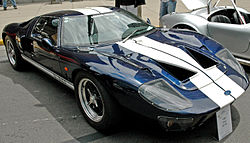
A "Roaring Forties" replica of a 1965 Ford GT40 in Shelby livery on display at the 2005 United States Grand Prix
As the price and the rarity of the Ford GT40 have increased, so has the demand for a continuation model as well as cheaper imitations and replicas of varying quality. There have been several kit cars and replicas made that have been inspired by the Ford GT40, as well as a continuation (exact and licensed replica):
- GT40/R Competition, United States: authentic GT40 built by Superformance and co-designed with Pathfinder Motorsports, it is the only race-version continuation model fully licensed by Safir GT40 Spares (Ltd). These carry continuation chassis numbers from the original cars. Approved for vintage racing by the Historic Sportscar Racing association (HSR), Bobby Rahal's Legends of Motorsports (LOM), and the Sportscar Vintage Racing Association (SVRA), it is distributed by Pathfinder Motorsports.A GT40/R (GT40P/2094) campaigned by Pathfinder Motorsports with an engine built by Holman Moody won both the 2009 US Vintage Grand Prix and the 2009 Governor's Cup at Watkins Glen.
- Holman Moody: GT40 Mark IIs won third at Le Mans in 1966, still manufacture a small number of GT40s from 1966 blueprints
Ford GT
At the 1995 Detroit Auto Show, the Ford GT90 concept was shown and at the 2002 show, a new GT40 Concept was unveiled by Ford.
While similar in appearance to the original cars, it was bigger, wider, and three inches taller than the original 40 inches (1.02 m). Three production prototype cars were shown in 2003 as part of Ford's centenary, and delivery of the production Ford GT began in the fall of 2004. The Ford GT was assembled in the Ford Wixom plant and painted by Saleen, Incorporated at their Saleen Special Vehicles plant in Troy, Michigan, USA.
A British company, Safir Engineering, who made continuation GT40s in the 1980s owned the GT40 trademark at that time, and when they completed production, they sold the excess parts, tooling, design, and trademark to a small American company called Safir GT40 Spares based in Ohio. Safir GT40 Spares licensed the use of the GT40 trademark to Ford for the initial 2002 show car, but when Ford decided to make the production vehicle, negotiations between the two failed, and as a result the new Ford GT does not wear the badge GT40. It is rumored that Safir GT40 Spares asked $40 million dollars for the rights, but this has never been verified. The partners at Safir GT40 Spares state they have correspondence from Ford declining Safir's $8 million offer. Later models or prototypes have also been called the Ford GT but have had different numbering on them such as the Ford GT90 or the Ford GT70. The GT40 name is currently licensed for use by the Pathfinder Motorsports GT40/R Competition, which is built by Hi-Tech in South Africa, which also builds street version models of the GT40.
Le Mans 24 Hour victories
| Le Mans 24 Hour victories |
|---|
| | | Distance | Speed |
| Year | Car | Drivers | km | mph | km/h |
| 1966 | Mk II | Chris Amon, Bruce McLaren | 4843.09 | 130.98 | 210.80 |
| 1967 | Mk IV | Dan Gurney, A. J. Foyt | 5232.9 | 135.48 | 218.03 |
| 1968 | Mk I | Pedro Rodríguez, Lucien Bianchi | 4452.88 | 115.29 | 185.54 |
| 1969 | Mk I | Jacky Ickx, Jackie Oliver | 4997.88 | 129.40 | 208.25 |
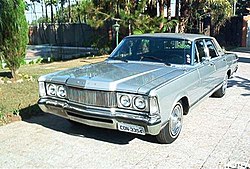 Ford Landau 1977
Ford Landau 1977


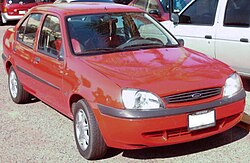


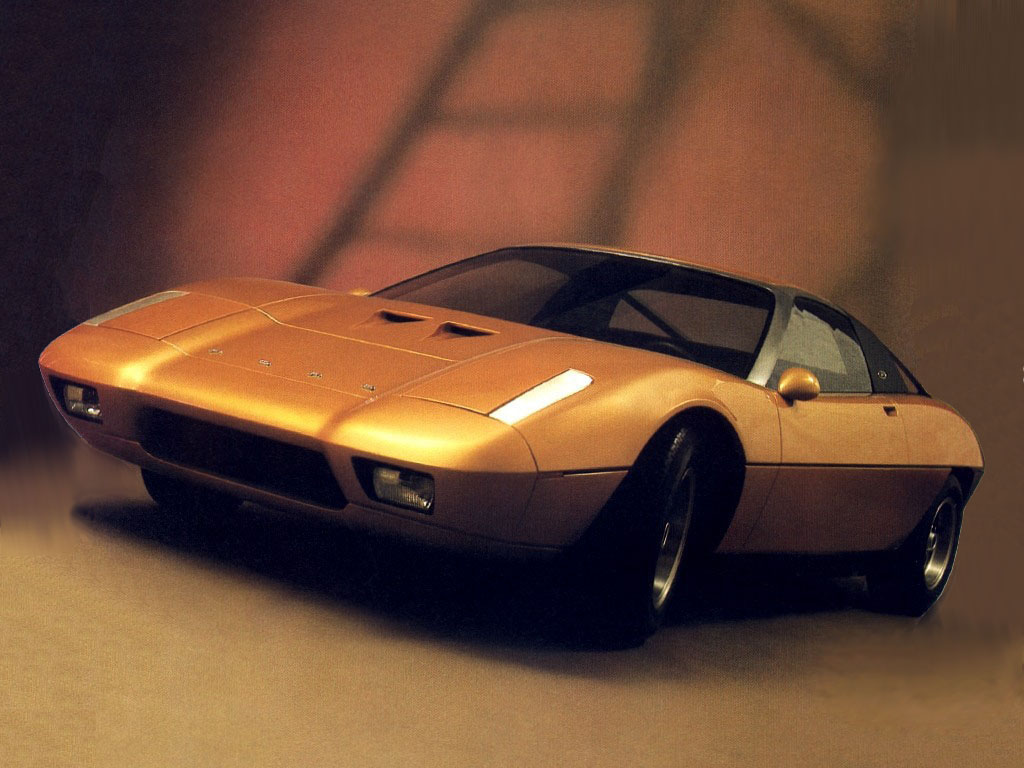












![Validate my RSS feed [Valid RSS]](valid-rss-rogers.png)














































































